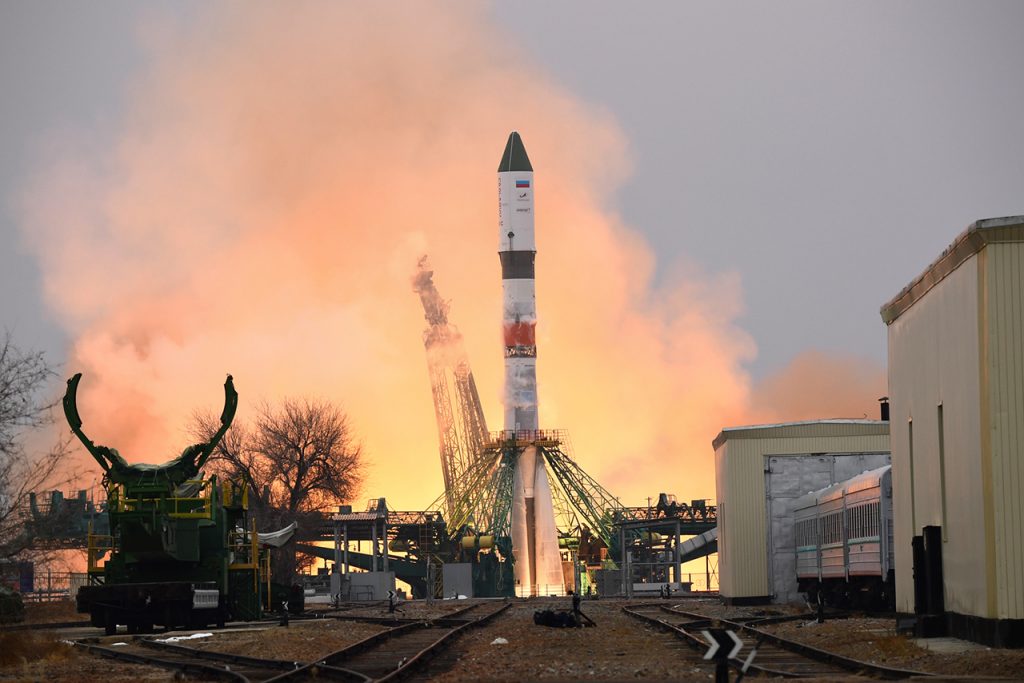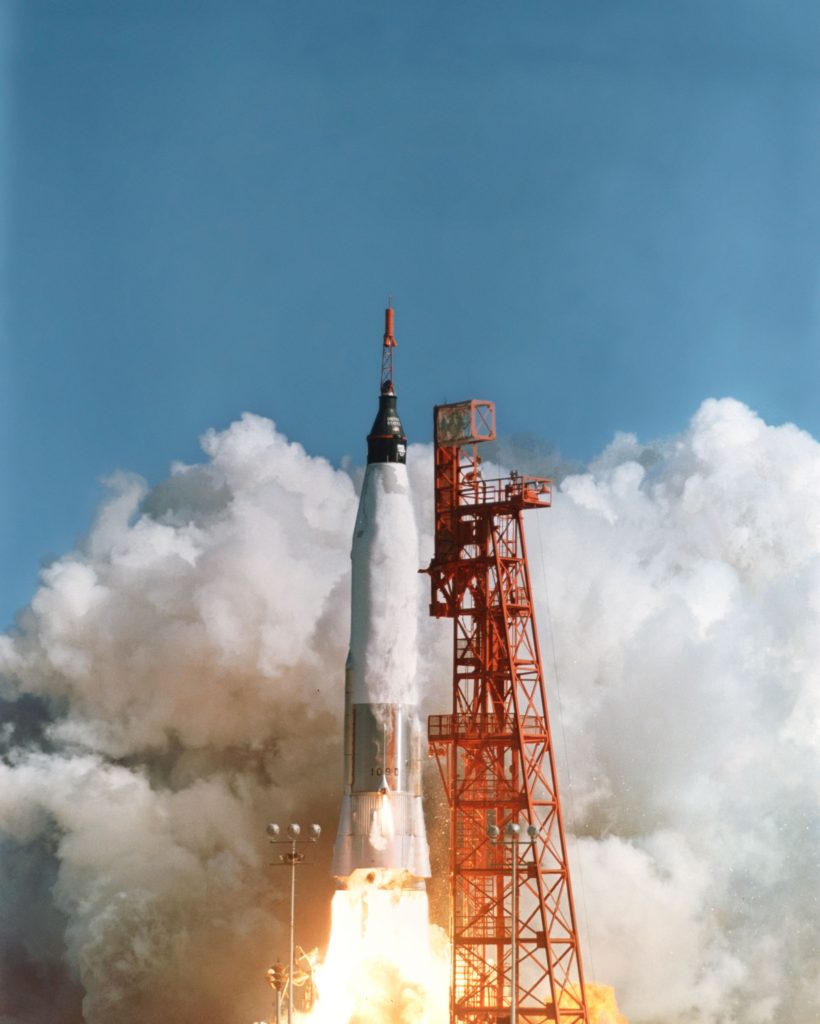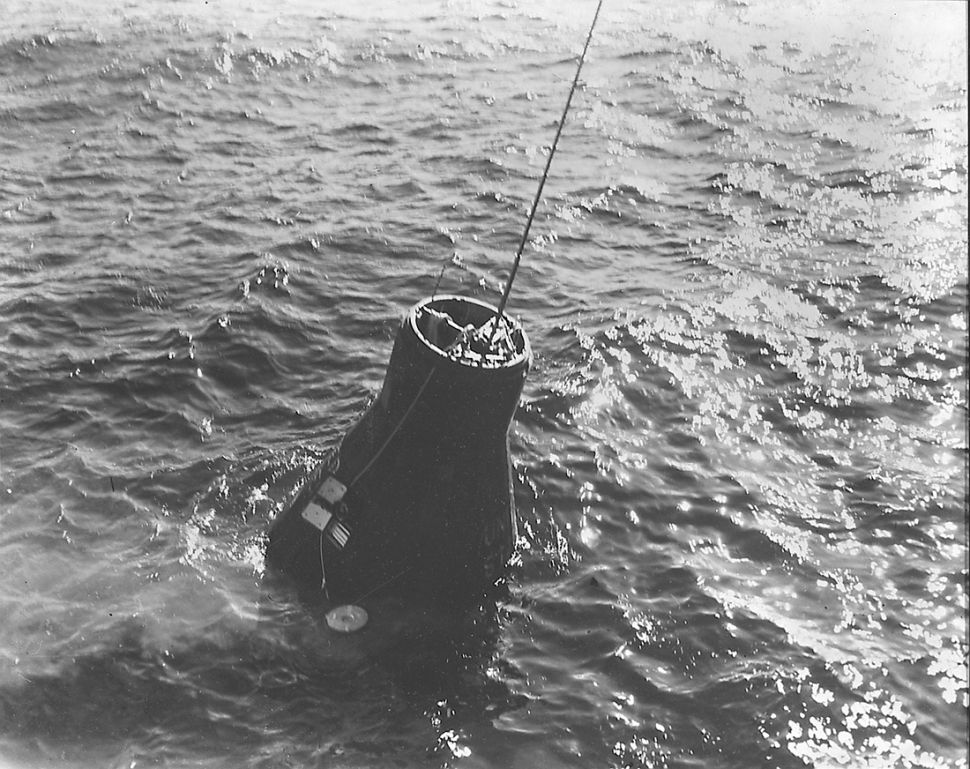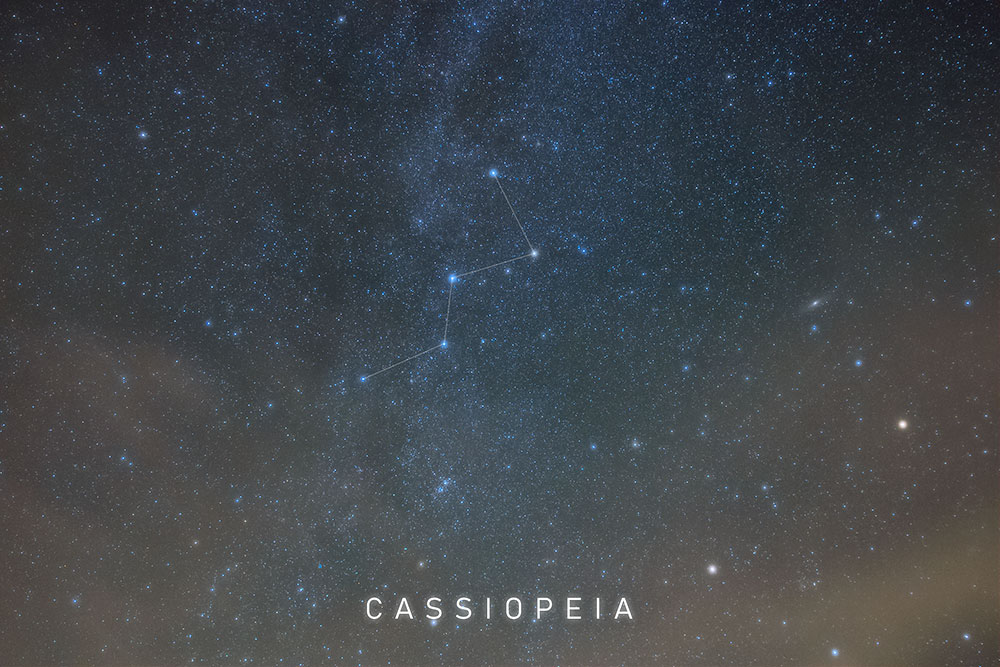Join us for this week’s Rocket Roundup with host Annie Wilson as we look back at the launches that happened over the last week, including two ISS resupply missions and Yet Another Starlink (with bonus booster landing fail). Plus, we look back at the Friendship 7 mission, which launched back on February 20th, 1962.
Media
Transcript
Hello, and welcome to the Daily Space. My name is Annie Wilson and most weekdays the CosmoQuest team is here putting science in your brain.
Today, however, is for Rocket Roundup. Let’s get to it, shall we?
First up this week is Progress MS-16, an ISS resupply mission that launched on February 15 at 04:45 UTC from Site 31-6 at the Baikonur Cosmodrome in Kazakhstan. After a two-day, 34-orbit trip, the uncrewed spacecraft successfully docked to the ISS.

The freighter’s automated rendezvous system failed when the vehicle was about thirty meters from the ISS. Russian cosmonaut Sergei Ryzhikov successfully brought the vehicle in manually using the Teleoperated Mode of Spacecraft Control system.
Progress MS-16 delivered 2,460 kilograms of supplies to the station including 600 kilograms of propellant, 420 liters of water for the Rodnik water reclamation system, 40.5 kilograms of compressed gases with additional reserves of nitrogen, and 1,400 kilograms of various equipment and materials. It also delivered resource equipment for onboard control and life support systems, repair and recovery kits, packages for the Russian space experiments program, medical control means and sanitary-hygienic supplies, clothes, and food rations.
One of the experiments included neuro lab kits to conduct a series of medical experiments to study the impact of long-duration space missions on the quality of professional activities of cosmonauts.
At the end of its mission in July 2021, Progress MS-16 will take the Pirs docking compartment with it to leave room for the arrival of the Nauka module later in 2021. Progress MS-16 will deorbit with the Pirs module attached sending both to a destructive reentry.
Next up: On February 16 at 03:59 UTC, Booster 1059 made its sixth, and as it would turn out, last flight from SLC-40 at Cape Canaveral Space Force Station. Onboard were another sixty Starlink satellites to add to the mega-constellation, bringing the total to 1,142 of a planned 1,440 satellites — just shy of being 80% complete.

This launch was normal through the first stage shutdown and separation. A keen observer might have noticed that the first stage reentry burn seemed a bit off from previous returns as it neared engine shutdown. At one point, the telemetry readings on-screen froze, indicating that SpaceX had lost telemetry. The webcast then switched to a camera on the drone ship, but the booster never appeared. The only evidence the booster got close to the barge was a bright orange flash in the cloud layer. Shortly after it was announced on the stream that the booster was lost on landing.
Not all was lost: the second stage and payload continued on and reached orbit. After a half-hour coast and short restart, the sixty satellites were successfully deployed into orbit, completing the primary mission. SpaceX expects to lose a small percentage of boosters as part of normal operations, so this is not a big deal in the long term.
All future Starlink missions have been delayed indefinitely while SpaceX investigates what happened with booster 1059.
Lastly, for this week, we have the Cygnus NG-15 spacecraft, which was launched on February 20 at 17:36 UTC aboard a Northrop Grumman Antares rocket from the Mid Atlantic Regional Spaceport on Wallops Island in Virginia. This marked the fourteenth launch of an Antares rocket since its debut in 2013.

The resupply spacecraft was dubbed the “S.S. Katherine Johnson,” which continued the tradition of naming the spacecraft after people important to the space program who have passed away. Katherine Johnson died exactly one year ago today, and we will have more to say about her in a moment.
The spacecraft carried 3,810 kilograms of equipment to the station, including 1,413 kilograms of vehicle hardware, 1,127 kilograms of scientific investigations, 932 kilograms of crew supplies, 24 kilograms of spacesuit parts, and 24 kilograms of supplies for the Russian segment.,
This Week in Rocket History
We now turn our heads to the past, with “This Week in Rocket History”, where every week we cover an important launch event that happened roughly around the same time in history, and this week we have a doozie!

On February 20, 1962, John Glenn was launched into space from Cape Canaveral in the Friendship 7Mercury capsule, sitting on top of an Atlas LV-3B launch vehicle.
The launch was initially delayed because of weather and various failures in the guidance and fueling systems, which were all eventually fixed, and the Mercury-Atlas vehicle launched successfully at 14:47 UTC.
The vehicle performed admirably, passing maximum dynamic pressure, or Max Q, at T+1:24, and at T+2:14 the booster engines cut off and were separated from the craft, followed by the escape tower twenty seconds later.
The Atlas then pitched over further and kept pushing the capsule until T+05:24 when the engines shut off, and John Glenn became the first American to achieve an orbital flight trajectory around the Earth. The Mercury-Atlas vehicle is notable for providing the quickest ascent-to-orbit of any crewed rocket. Glenn experienced nearly 8 Gs on the ascent.
Once on orbit, ground controllers informed Glenn that he would be able to complete at least seven orbits, while the computers at the Goddard Space Flight Center predicted that he was moving fast enough to complete a hundred orbits.
The capsule separated from the rocket using its posigrade rockets, but a five-second rate dampening operation which was supposed to be initiated at the same time started two and a half seconds too late, causing the capsule to begin its 180° turnaround maneuver with a substantial initial roll. The attitude systems managed to compensate for the error at the expense of a little more fuel than originally anticipated.

Initially, everything seemed to be going perfectly, with all systems “go” as Glenn flew over the Atlantic. As he passed over Nigeria, however, Glenn noticed that his instruments were indicating the capsule was in the wrong attitude, so he took manual control and adjusted the yaw so that he was more properly aligned with the desired orientation.
Glenn’s flight path took him and Friendship 7 over the city of Perth in Australia, where many people turned on their lights so that Glenn could see them as he flew over. Shortly thereafter, the sun began to rise on Friendship 7, and Glenn reported seeing “thousands of little specks, brilliant specks, floating around outside the capsule”. Those only appeared as the sun was starting to rise and completely disappeared when the sunlight was stronger. It was later determined that those were probably ice crystals venting from the spacecraft’s systems.
When he was nearing the end of his first orbit, Glenn once again noticed issues with his yaw flight controls. He observed a drift to the right of about a degree and a half per second, and once again switched to manual control in order to correct his yaw using fly-by-wire, a system which controlled the vehicle’s systems electronically rather than via mechanical linkages, which he had to keep using for the rest of the flight despite the automated system intermittently kicking in.
Interestingly, the same problem had occurred previously on the Mercury-Atlas 5, which was crewed by the chimp Enos was not trained to fly manually, so the flight had to be aborted early. Enos, for those worried, survived the harrowing experience.
It was in the second orbit, however, that things started getting really concerning. An engineer named William Saunders noticed that a sensor that provided data on the spacecraft’s landing system, called “Segment 51”, was reporting that the heat shield and landing bag were no longer in their default “locked” position, meaning they might be loose and could be damaged during re-entry or worse. The controllers did not inform Glenn right away but did instruct him to ensure the landing bag switch was set to “off”.
During his third orbit, Glenn was instructed to test the landing bag deploy switch again, at which point he realized they must have found a problem with it. The test was technically successful, as no warning lights lit up, but ground control was not satisfied. They decided to keep the retrorockets attached to the capsule during re-entry, as the rocket pack went over the heatshield and would help keep it in place. This would only be possible if all the retrorockets fired, otherwise any unspent fuel would be ignited upon re-entry. There was also a concern that the rocket pack would disintegrate due to the excess heat of reentry, but it was determined that by the time that happened the atmospheric pressure would be enough to push back against the heat shield and keep it attached.

As the capsule got close to the California coast, Glenn fired his retrorockets — which thankfully all fired — and then angled his spacecraft into a 14-degree nose-up pitch for re-entry. As the capsule started re-entering the atmosphere, Glenn reported he saw chunks of debris flying past his window, which he was afraid was the heatshield, but it ended up being parts of the retrorockets, as anticipated by the engineers on the ground.
When the capsule reached maximum g, Glenn lost manual control and the capsule started oscillating violently. He used the auxiliary dampening systems to try and smooth the motion of the spacecraft in hopes to regain enough stability by the time he had to deploy his drogue chutes. It worked for a short while, but even the auxiliary systems ran out of fuel eventually, and 51 seconds before chute deployment, it started oscillating again. Glenn was going to deploy the chutes early to regain attitude control, but the automated systems of the capsule beat him to it, and the spacecraft started gaining stability and eventually splashed down safely in the North Atlantic.
Investigations after the fact have determined that both the landing bag and the heat shield were functioning properly, and “Segment 51” was simply having a sensor malfunction.

In the years to follow the stressful yet successful flight of Friendship 7, the capsule was taken on a tour around the world, known as “The Fourth Orbit of Friendship 7”. The Friendship 7 capsule now resides in the National Air and Space Museum in Washington DC, and John Glenn became a national hero, but the mission would not have gotten off the ground without the work of another, now-famous figure: Katherine Johnson.
According to an article from NPR, Johnson’s calculations were an indispensable part of Glenn’s preflight routine, apparently asking her personally to double-check the “new computer” calculations of Friendship 7’s planned flight. Mrs. Johnson recalled that “When he got ready to go, he said, ‘Call her. And if she says the computer is right, I’ll take it’.”
In the words of Margaret Lee Shetterly, author of the book Hidden Figures: the astronaut who became a hero, looked to this Black woman in the still-segregated South at the time as one of the key parts of making sure his mission would be a success.
On this, the one-year anniversary of her passing, we here at CosmoQuest salute her, and all the other heroes at NASA who made this moment in history possible, providing the foundation for the seemingly routine space flights of today. It doesn’t happen without people like Katherine Johnson.
To wrap things up, here’s a running tally of a few spaceflight statistics for the current year:
Toilets currently in space: 5 — 3 installed on ISS, 1 on the Crew Dragon, 1 on the Soyuz
Total 2021 orbital launch attempts: 14
Total satellites from launches: 341
I keep track of orbital launches by where they launched from, also known as spaceport. Here’s that breakdown:
USA: 7
China: 4
Kazakhstan: 1
New Zealand: 1
Russia: 1
Random Space Fact

Our space fact of the week comes to us from CosmoQuest community member UncWilly who told us about a visible star in a classic constellation that had no traditional Arabic or Latin name until the mid-twentieth century. Gamma Cassiopeiae, which is the center star of the very distinctive ‘W’ asterism in the northern sky, was given the informal name Navi by Gus Grissom, which is his middle name Ivan spelled backward.
Iota Ursa Majoris got the name Dnoces (‘second’ backward) after Edward H. White II, Grissom’s crewmate, by Gus.
Gamma Velorum got the name Regor (‘Roger’ spelled in reverse) for Roger Chaffee, same way.
Learn More
Roscosmos Launches Progress MS-16 Resupply Mission to ISS
- Launch video
- Spaceflight Now article
Another 60 Starlink Satellites in Orbit, Booster Lost
- SpaceX launch notes (Archive.org)
- Launch video
Cygnus NG-15 Resupply Mission Lifts Off From Wallops
- Launch video
- NASA blog (launch)
- Northrup Grumman press release
- NASA mission overview (pdf)
- NASA blog (arrival)
This Week in Rocket History: Friendship 7
- NASA article
- Katherine Johnson obituary (NPR)
- Mercury-Atlas 6 article (NASA)
- Western Australian Museum article
- The Mystery of John Glenn’s Fireflies Returns (Universe Today)
- ‘Hidden Figures’: How Black Women Did The Math That Put Men On The Moon (NPR)
Random Space Fact: Gamma Cassiopeiae Named by Gus Grissom
Credits
Host: Annie Wilson
Writers: Elad Avron, Dave Ballard, Gordon Dewis, Pamela Gay, Beth Johnson, Erik Madaus, Ally Pelphrey, and Annie Wilson
Audio and Video Editing: Ally Pelphrey
Content Editing: Beth Johnson
Executive Producer: Pamela Gay
Intro and Outro music by Kevin MacLeod, https://incompetech.com/music/


 We record most shows live, on Twitch. Follow us today to get alerts when we go live.
We record most shows live, on Twitch. Follow us today to get alerts when we go live.